Weixi Feng
BlobGEN-Vid: Compositional Text-to-Video Generation with Blob Video Representations
Jan 13, 2025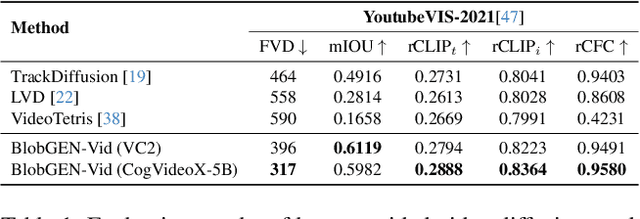
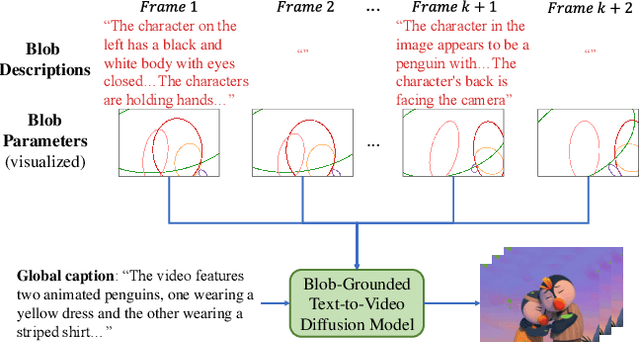


Abstract:Existing video generation models struggle to follow complex text prompts and synthesize multiple objects, raising the need for additional grounding input for improved controllability. In this work, we propose to decompose videos into visual primitives - blob video representation, a general representation for controllable video generation. Based on blob conditions, we develop a blob-grounded video diffusion model named BlobGEN-Vid that allows users to control object motions and fine-grained object appearance. In particular, we introduce a masked 3D attention module that effectively improves regional consistency across frames. In addition, we introduce a learnable module to interpolate text embeddings so that users can control semantics in specific frames and obtain smooth object transitions. We show that our framework is model-agnostic and build BlobGEN-Vid based on both U-Net and DiT-based video diffusion models. Extensive experimental results show that BlobGEN-Vid achieves superior zero-shot video generation ability and state-of-the-art layout controllability on multiple benchmarks. When combined with an LLM for layout planning, our framework even outperforms proprietary text-to-video generators in terms of compositional accuracy.
TC-Bench: Benchmarking Temporal Compositionality in Text-to-Video and Image-to-Video Generation
Jun 12, 2024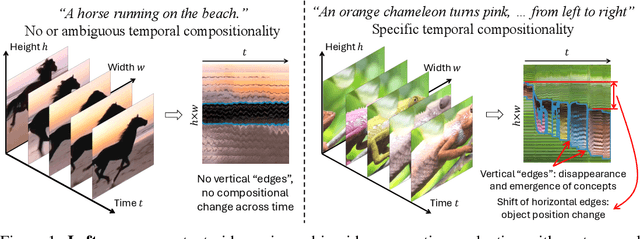



Abstract:Video generation has many unique challenges beyond those of image generation. The temporal dimension introduces extensive possible variations across frames, over which consistency and continuity may be violated. In this study, we move beyond evaluating simple actions and argue that generated videos should incorporate the emergence of new concepts and their relation transitions like in real-world videos as time progresses. To assess the Temporal Compositionality of video generation models, we propose TC-Bench, a benchmark of meticulously crafted text prompts, corresponding ground truth videos, and robust evaluation metrics. The prompts articulate the initial and final states of scenes, effectively reducing ambiguities for frame development and simplifying the assessment of transition completion. In addition, by collecting aligned real-world videos corresponding to the prompts, we expand TC-Bench's applicability from text-conditional models to image-conditional ones that can perform generative frame interpolation. We also develop new metrics to measure the completeness of component transitions in generated videos, which demonstrate significantly higher correlations with human judgments than existing metrics. Our comprehensive experimental results reveal that most video generators achieve less than 20% of the compositional changes, highlighting enormous space for future improvement. Our analysis indicates that current video generation models struggle to interpret descriptions of compositional changes and synthesize various components across different time steps.
MMWorld: Towards Multi-discipline Multi-faceted World Model Evaluation in Videos
Jun 12, 2024



Abstract:Multimodal Language Language Models (MLLMs) demonstrate the emerging abilities of "world models" -- interpreting and reasoning about complex real-world dynamics. To assess these abilities, we posit videos are the ideal medium, as they encapsulate rich representations of real-world dynamics and causalities. To this end, we introduce MMWorld, a new benchmark for multi-discipline, multi-faceted multimodal video understanding. MMWorld distinguishes itself from previous video understanding benchmarks with two unique advantages: (1) multi-discipline, covering various disciplines that often require domain expertise for comprehensive understanding; (2) multi-faceted reasoning, including explanation, counterfactual thinking, future prediction, etc. MMWorld consists of a human-annotated dataset to evaluate MLLMs with questions about the whole videos and a synthetic dataset to analyze MLLMs within a single modality of perception. Together, MMWorld encompasses 1,910 videos across seven broad disciplines and 69 subdisciplines, complete with 6,627 question-answer pairs and associated captions. The evaluation includes 2 proprietary and 10 open-source MLLMs, which struggle on MMWorld (e.g., GPT-4V performs the best with only 52.3\% accuracy), showing large room for improvement. Further ablation studies reveal other interesting findings such as models' different skill sets from humans. We hope MMWorld can serve as an essential step towards world model evaluation in videos.
T2V-Turbo: Breaking the Quality Bottleneck of Video Consistency Model with Mixed Reward Feedback
May 29, 2024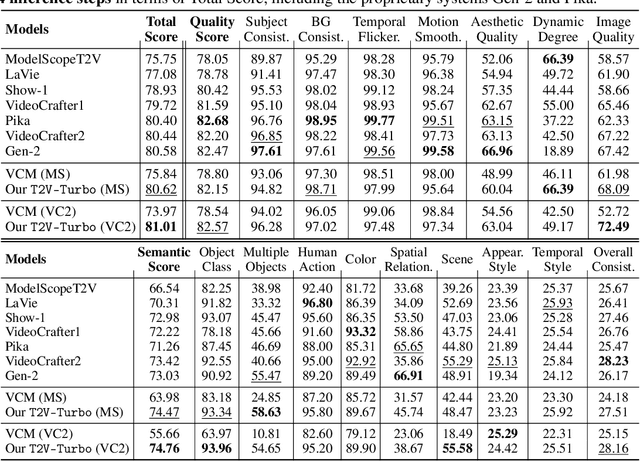
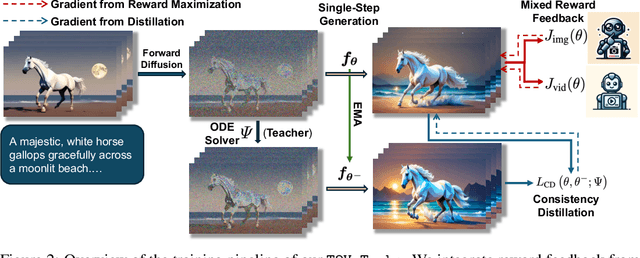
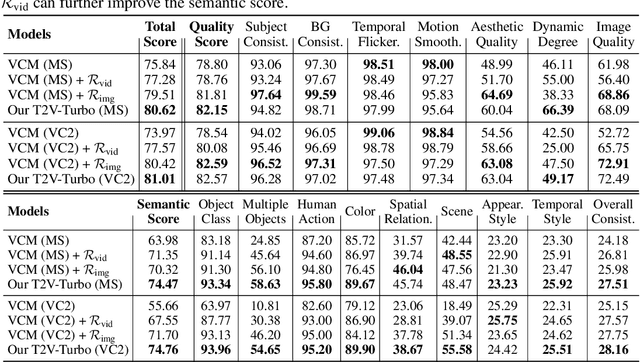
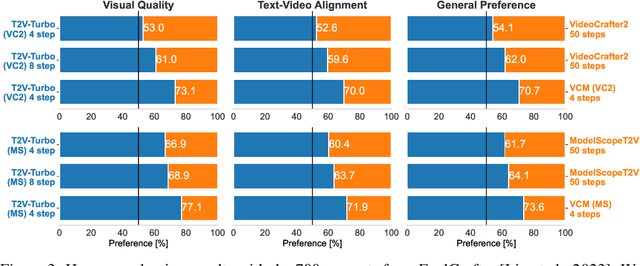
Abstract:Diffusion-based text-to-video (T2V) models have achieved significant success but continue to be hampered by the slow sampling speed of their iterative sampling processes. To address the challenge, consistency models have been proposed to facilitate fast inference, albeit at the cost of sample quality. In this work, we aim to break the quality bottleneck of a video consistency model (VCM) to achieve $\textbf{both fast and high-quality video generation}$. We introduce T2V-Turbo, which integrates feedback from a mixture of differentiable reward models into the consistency distillation (CD) process of a pre-trained T2V model. Notably, we directly optimize rewards associated with single-step generations that arise naturally from computing the CD loss, effectively bypassing the memory constraints imposed by backpropagating gradients through an iterative sampling process. Remarkably, the 4-step generations from our T2V-Turbo achieve the highest total score on VBench, even surpassing Gen-2 and Pika. We further conduct human evaluations to corroborate the results, validating that the 4-step generations from our T2V-Turbo are preferred over the 50-step DDIM samples from their teacher models, representing more than a tenfold acceleration while improving video generation quality.
Reward Guided Latent Consistency Distillation
Mar 16, 2024Abstract:Latent Consistency Distillation (LCD) has emerged as a promising paradigm for efficient text-to-image synthesis. By distilling a latent consistency model (LCM) from a pre-trained teacher latent diffusion model (LDM), LCD facilitates the generation of high-fidelity images within merely 2 to 4 inference steps. However, the LCM's efficient inference is obtained at the cost of the sample quality. In this paper, we propose compensating the quality loss by aligning LCM's output with human preference during training. Specifically, we introduce Reward Guided LCD (RG-LCD), which integrates feedback from a reward model (RM) into the LCD process by augmenting the original LCD loss with the objective of maximizing the reward associated with LCM's single-step generation. As validated through human evaluation, when trained with the feedback of a good RM, the 2-step generations from our RG-LCM are favored by humans over the 50-step DDIM samples from the teacher LDM, representing a 25 times inference acceleration without quality loss. As directly optimizing towards differentiable RMs can suffer from over-optimization, we overcome this difficulty by proposing the use of a latent proxy RM (LRM). This novel component serves as an intermediary, connecting our LCM with the RM. Empirically, we demonstrate that incorporating the LRM into our RG-LCD successfully avoids high-frequency noise in the generated images, contributing to both improved FID on MS-COCO and a higher HPSv2.1 score on HPSv2's test set, surpassing those achieved by the baseline LCM.
VELMA: Verbalization Embodiment of LLM Agents for Vision and Language Navigation in Street View
Jul 12, 2023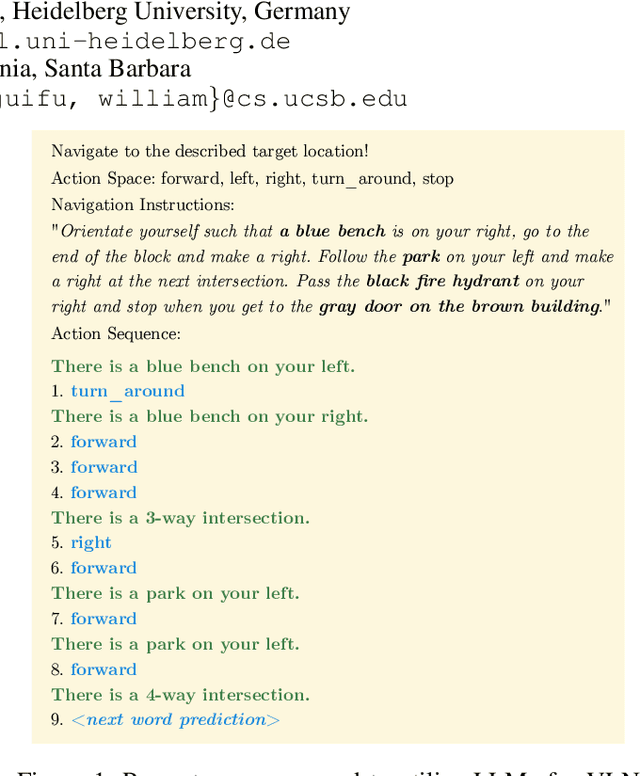
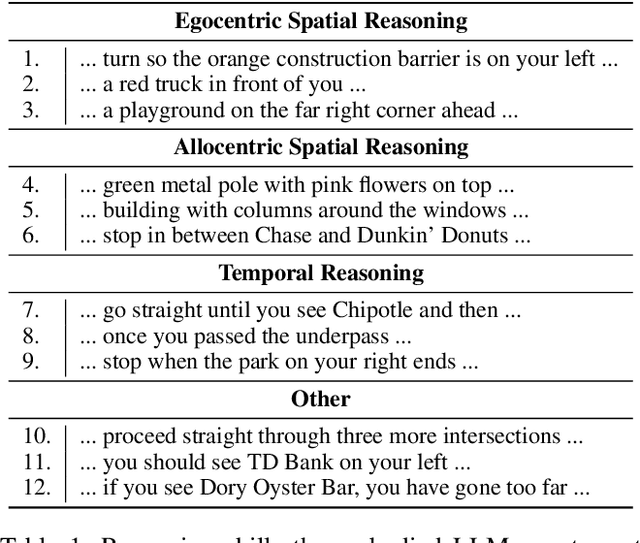
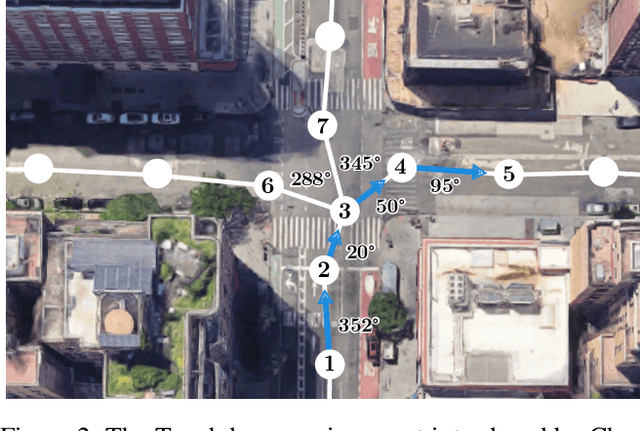
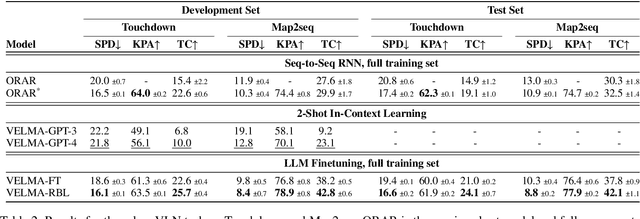
Abstract:Incremental decision making in real-world environments is one of the most challenging tasks in embodied artificial intelligence. One particularly demanding scenario is Vision and Language Navigation~(VLN) which requires visual and natural language understanding as well as spatial and temporal reasoning capabilities. The embodied agent needs to ground its understanding of navigation instructions in observations of a real-world environment like Street View. Despite the impressive results of LLMs in other research areas, it is an ongoing problem of how to best connect them with an interactive visual environment. In this work, we propose VELMA, an embodied LLM agent that uses a verbalization of the trajectory and of visual environment observations as contextual prompt for the next action. Visual information is verbalized by a pipeline that extracts landmarks from the human written navigation instructions and uses CLIP to determine their visibility in the current panorama view. We show that VELMA is able to successfully follow navigation instructions in Street View with only two in-context examples. We further finetune the LLM agent on a few thousand examples and achieve 25%-30% relative improvement in task completion over the previous state-of-the-art for two datasets.
LayoutGPT: Compositional Visual Planning and Generation with Large Language Models
May 24, 2023
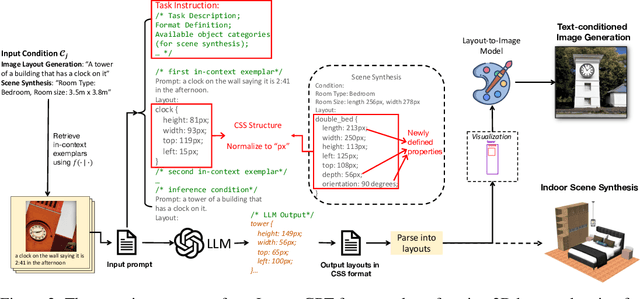
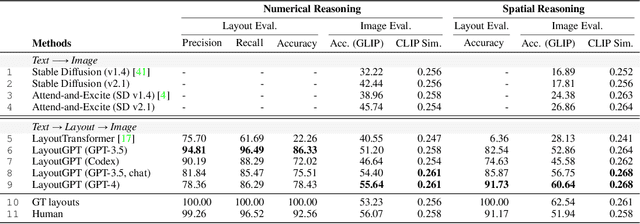
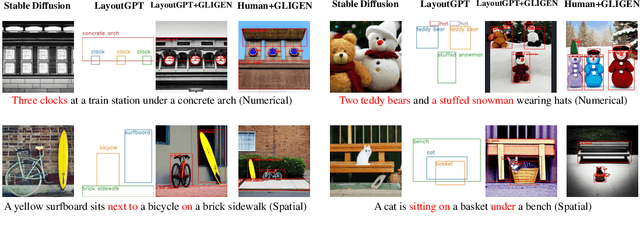
Abstract:Attaining a high degree of user controllability in visual generation often requires intricate, fine-grained inputs like layouts. However, such inputs impose a substantial burden on users when compared to simple text inputs. To address the issue, we study how Large Language Models (LLMs) can serve as visual planners by generating layouts from text conditions, and thus collaborate with visual generative models. We propose LayoutGPT, a method to compose in-context visual demonstrations in style sheet language to enhance the visual planning skills of LLMs. LayoutGPT can generate plausible layouts in multiple domains, ranging from 2D images to 3D indoor scenes. LayoutGPT also shows superior performance in converting challenging language concepts like numerical and spatial relations to layout arrangements for faithful text-to-image generation. When combined with a downstream image generation model, LayoutGPT outperforms text-to-image models/systems by 20-40% and achieves comparable performance as human users in designing visual layouts for numerical and spatial correctness. Lastly, LayoutGPT achieves comparable performance to supervised methods in 3D indoor scene synthesis, demonstrating its effectiveness and potential in multiple visual domains.
EDIS: Entity-Driven Image Search over Multimodal Web Content
May 23, 2023



Abstract:Making image retrieval methods practical for real-world search applications requires significant progress in dataset scales, entity comprehension, and multimodal information fusion. In this work, we introduce \textbf{E}ntity-\textbf{D}riven \textbf{I}mage \textbf{S}earch (EDIS), a challenging dataset for cross-modal image search in the news domain. EDIS consists of 1 million web images from actual search engine results and curated datasets, with each image paired with a textual description. Unlike datasets that assume a small set of single-modality candidates, EDIS reflects real-world web image search scenarios by including a million multimodal image-text pairs as candidates. EDIS encourages the development of retrieval models that simultaneously address cross-modal information fusion and matching. To achieve accurate ranking results, a model must: 1) understand named entities and events from text queries, 2) ground entities onto images or text descriptions, and 3) effectively fuse textual and visual representations. Our experimental results show that EDIS challenges state-of-the-art methods with dense entities and a large-scale candidate set. The ablation study also proves that fusing textual features with visual features is critical in improving retrieval results.
Discriminative Diffusion Models as Few-shot Vision and Language Learners
May 18, 2023



Abstract:Diffusion models, such as Stable Diffusion, have shown incredible performance on text-to-image generation. Since text-to-image generation often requires models to generate visual concepts with fine-grained details and attributes specified in text prompts, can we leverage the powerful representations learned by pre-trained diffusion models for discriminative tasks such as image-text matching? To answer this question, we propose a novel approach, Discriminative Stable Diffusion (DSD), which turns pre-trained text-to-image diffusion models into few-shot discriminative learners. Our approach uses the cross-attention score of a Stable Diffusion model to capture the mutual influence between visual and textual information and fine-tune the model via attention-based prompt learning to perform image-text matching. By comparing DSD with state-of-the-art methods on several benchmark datasets, we demonstrate the potential of using pre-trained diffusion models for discriminative tasks with superior results on few-shot image-text matching.
Training-Free Structured Diffusion Guidance for Compositional Text-to-Image Synthesis
Dec 09, 2022



Abstract:Large-scale diffusion models have achieved state-of-the-art results on text-to-image synthesis (T2I) tasks. Despite their ability to generate high-quality yet creative images, we observe that attribution-binding and compositional capabilities are still considered major challenging issues, especially when involving multiple objects. In this work, we improve the compositional skills of T2I models, specifically more accurate attribute binding and better image compositions. To do this, we incorporate linguistic structures with the diffusion guidance process based on the controllable properties of manipulating cross-attention layers in diffusion-based T2I models. We observe that keys and values in cross-attention layers have strong semantic meanings associated with object layouts and content. Therefore, we can better preserve the compositional semantics in the generated image by manipulating the cross-attention representations based on linguistic insights. Built upon Stable Diffusion, a SOTA T2I model, our structured cross-attention design is efficient that requires no additional training samples. We achieve better compositional skills in qualitative and quantitative results, leading to a 5-8% advantage in head-to-head user comparison studies. Lastly, we conduct an in-depth analysis to reveal potential causes of incorrect image compositions and justify the properties of cross-attention layers in the generation process.
 Add to Chrome
Add to Chrome Add to Firefox
Add to Firefox Add to Edge
Add to Edge